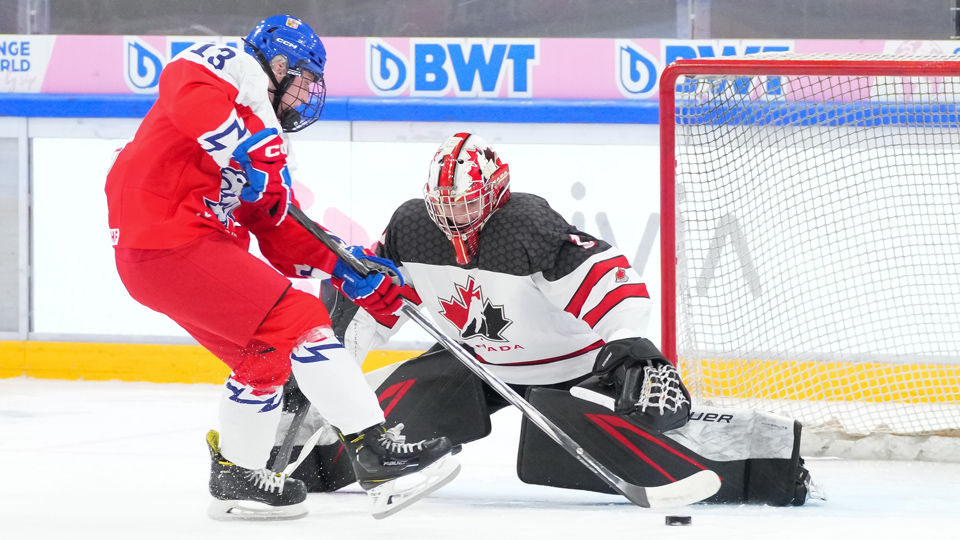
Schedule
Team Canada (Men)
IIHF World Junior Championship | Dec. 26, 2024-Jan. 5, 2025
Spengler Cup | Dec. 26-31, 2024
4 Nations Face-Off | Feb 12-20, 2025
IIHF U18 World Championship | April 23-May 3, 2025
IIHF World Championship | May 9-25, 2025
U17 World Challenge | Nov. 3-9, 2024
Hlinka Gretzky Cup | Aug. 5-10, 2024
Junior A World Challenge | Dec. 9-15, 2024
National Junior Team vs. USPORTS | Dec 12-13, 2024
Search

Catching up with the Class of 2008
Amanda Mazzotta, Laura McIntosh and Carolyne Prevost on their memories of the first U18 women’s worlds and where the game has taken them since

The team would win silver, and in the years after many of the 20 players continued to represent Canada internationally, including at the Olympic Winter Games.
As the tournament returns to Canada for the first time since that inaugural event in Calgary, Alta., this time with St. Catharines, Ont., playing host, three members of the 2008 team share their memories of the event and how they’ve stayed involved in the game.
Amanda Mazzotta Most of the players on the 2008 team were born in 1990, the same year the first IIHF World Women’s Championship was held. It was a point not lost on the players, says Mazzotta, who won two games and posted a 0.67 goals-against average. “We spent a lot of time talking about those players and the path they’d taken, and the path they created for us to make it easier for girls to play.”
Fans filled the stands for all of Canada’s games at Father David Bauer Olympic Arena. “I remember even the games I wasn’t playing just trying to hear the coaches on the bench because there were so many little kids screaming and everyone [cheering]. You can’t get much better than that.”
Mazzotta went on to play for Canada’s National Women’s Development Team at the 2012 Meco Cup, as well as for Cornell University, winning 53 games (22 via shutout) in four years.
After graduating she returned home to London, Ont., to complete her master’s degree in coaching at the University of Western Ontario. She served as an assistant and goaltending coach for the women’s hockey team, while also returning to her minor hockey roots and helping the London Devilettes’ Junior and Bantam AA teams.
Last season she came full circle, serving as the goalie coach – as part of an all-Hockey Canada alumnae staff – for Canada’s National Women’s Under-18 Team.
“I think that’s good for the girls because they have coaches and role models who were exactly where they want to be and where they were in that moment, so we understand the stress and the pressure,” she says.
Mazzotta recently captured a gold medal at the Nations Cup as the goalie coach for Canada’s National Women’s Development Team. She’s also in her first season with Quinnipiac University.
“There were so many influential people in my life who made hockey such a great experience,” says Mazzotta; hopefully, I can give that experience to young girls, whether it’s at the grassroots level, college hockey or the international level.”
Laura McIntosh “You could tell in warm-ups and during the game everyone was on board no matter their role on the team,” says McIntosh, who finished with four points. “Everyone embraced just being there in the moment and knowing it was the first U18 [women’s] world championship.”
The forward’s family travelled from Waterloo, Ont., to Calgary to watch her compete, and McIntosh, herself, loved meeting players and hockey personnel from across the country who shared her passion for the game.
“We didn’t get gold, but I had a lot of fun and I felt like that was the moment where I grew as a player.”
McIntosh went on to make two appearances for Canada’s National Women’s Development Team and graduated from Ohio State University as the school’s all-time leading scorer, a distinction she still holds. She currently plays with the Brampton Thunder of the Canadian Women’s Hockey League.
She’s also in her third year as an assistant coach with Wilfrid Laurier University’s women’s hockey team. And a year-and-a-half ago, she started LMcIntosh Hockey, a school devoted to female hockey development. Having typically travelled an hour from home to play high-level female hockey growing up, McIntosh wanted to help more girls stay in the community.
“I love being on the ice with girls and developing their skills,” she says. “They’re very keen to get better and they love the game. I like being around that atmosphere because I’m very passionate about the game, playing and coaching.”
Carolyne Prevost Many of the players wore the national sweater in a three-game summer series against the United States, says Prevost, but there was something special about wearing it at a world championship. The players put their jerseys on in unison. “That was a special moment for us to share together and step out on the ice as the first National Women’s Under-18 Team,” says Prevost, who finished with six goals and three assists.
Off-ice opportunities also fill the memory bank, with one in particular proving prophetic in a way. The team visited elementary schools and shared their stories with students. Today, Prevost teaches gym and social sciences at École secondaire Gaétan-Gervais in Oakville, Ont., and coaches the school’s mixed hockey team.
Many students know of her accomplishments. In fact, two buses came to watch her and the Toronto Furies win the Clarkson Cup last year. And on her recent birthday, her Grade 7 and 8 students presented her with a hockey stick they signed.
“I was always signing sticks with teams and giving it to different people,” says Prevost, “so it was a neat gift to get a signed stick from all of my students.”
Prevost, who went on to win three gold medals with Canada’s National Women’s Development Team, is in her third season with the Furies, after playing a season with the Montreal Stars (now Canadiennes).
“It’s been a great experience to be in the CWHL and see the growth of that league from even four years ago when I entered to now,” she says. Sports networks are now broadcasting games. “The sport is evolving as a whole. I was a part of the first U18 team and now a part of a lot of firsts with the CWHL.”
For more information: |
- <
- >
































 Chloe Primerano plays the puck against Germany.
Chloe Primerano plays the puck against Germany. Rhyah Stewart makes a save against Czechia.
Rhyah Stewart makes a save against Czechia.











